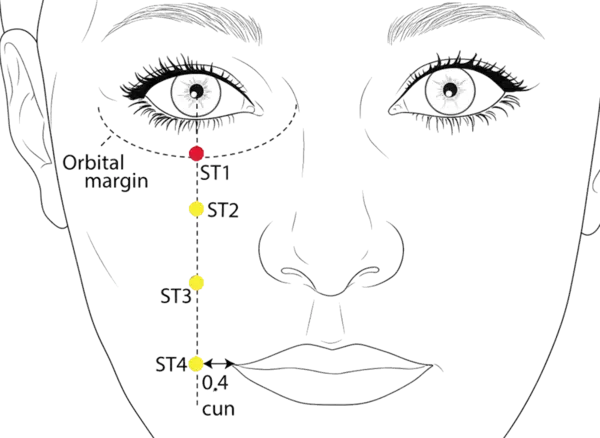ST-1 - Container of Tears
承泣 - Chéng qì
Point Region: Face
ST-1 Chengqi, known as 'Container of Tears,' holds profound wisdom about the relationship between emotional release and physical nourishment. Positioned directly below the pupil like a chalice waiting to catch falling tears, this point understands that sometimes we must empty ourselves completely before we can be filled with new vitality and clear vision.
In the delicate ecosystem of the eye, ST-1 serves as both guardian and cleanser, protecting our windows to the world while ensuring they remain clear and bright. This point bridges the gap between inner emotional landscape and outer perception, recognizing that what we see is often colored by what we feel, and true healing requires addressing both the tears we shed and the clarity we seek.
As the starting point of the Stomach meridian—our body's primary pathway for receiving and processing nourishment—ST-1 reminds us that we 'digest' our visual experiences just as we digest food. When this point is balanced, we can look upon the world with fresh eyes, neither clouded by old sorrows nor distorted by unprocessed emotional residue.
Location & How to Find
Anatomical Location: Directly below the pupil, between the eyeball and the infraorbital ridge, in the infraorbital foramen area.
How to Locate:
- Look straight ahead in a mirror
- Find the center of your pupil
- Move your finger directly down from your pupil to the bony ridge below your eye
- The point is in the small depression on this bony ridge

Primary Functions
Eye & Vision System
- Treats eye disorders and visual disturbances
- Relieves eye strain and fatigue
- Reduces eye swelling and inflammation
- Improves tear production and eye moisture
Nervous System
- Alleviates facial paralysis and nerve disorders
- Calms facial muscle spasms
- Reduces facial tension and stress
Digestive System
- Supports stomach qi circulation in the face
- Improves nutrient absorption affecting facial health
Clinical Applications
Primary Indications
- Eye redness
- Eye swelling
- Eye pain
- Excessive tearing
- Blurred vision
- Night blindness
- Facial paralysis
- Dry eyes
- Eye strain
- Visual disturbances
Related Health Concerns
Common Conditions:
Related Acupoints
Select a point to learn about its location, primary functions, clinical applications, and protocols.
ST-1 Protocols
N/A
Important Precautions
- Recent eye surgery
- Severe eye infections
- Glaucoma
- Eye injuries